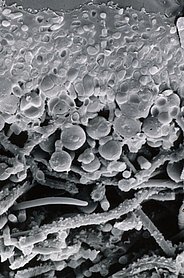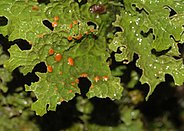The lung lichen is a conspicuous and easily recognizable foliose lichen. In Central Europe it mainly grows on old deciduous trees. Lobaria pulmonaria is characterisitc in old-growth forests and primeval forest landscapes. The species has suffered a tremendous decline during the last 100 years and is now vulnerable in Switzerland and endangered, critically endangered or regionally extinct in other countries in Europe, North America and Asia. We study the biology and threats of L. pulmonaria and other threatened forest lichens.
Contents ¶
Symbiosis ¶
Lichens are symbioses of a fungus and a photosynthetic microorganism, usually a green alga or a cyanobacterium. The lung lichen belongs to the ascomycetes. The fungal partner is associated with a green alga (Dictyochloropsis reticulata) and a cyanobacterium (Nostoc sp.).
Population genetics ¶

Our team has developed symbiont-specific microsatellite markers, and we have characterized the mating type idiomorphs of L. pulmonaria, which allow us to study:
- Effects of natural and anthropogenic disturbance on genetic diversity
- Dispersal distances using molecular methods in the field
- Spatial structure of the gene and genotype diversity
- Phylogeography
- Biased mating type frequencies in L. pulmonaria in Europe
The fungal partner of the lichen can reproduce sexually under certain conditions (by ascospores). However, vegetative propagation with propagules, which include both the fungal as well as the algal partners is more frequent. Our studies have shown that the dispersal distances are dependent on the forest structure and hence forest management. Intensive forest management usually leads to local extinction of the lung lichen, but also less intensive management leads to a reduced genetic diversity compared to situations in primeval forest reserves.
In primeval forests genotype diversity is maintained at a high level even at a small spatial scale. A high genotype diversity is hypothesized to be linked with a high admixture of the two different mating type idiomorphs and may thus have a favourable effect on sexual reproduction of this heterothallic lichen species.
Phylogeography ¶
The widespread lung lichen Lobaria pulmonaria is genetically differentiated into several genetic groups. In Central Europe, two distinct genetic groups are admixed. Studies from South East Europe revealed that one gene pool grows on trees growing in riparian forests, whereas the second gene pool is growing on beech in Mediterranean mountain forests. The fungal and algal symbionts share a very similar phylogeographic pattern.

